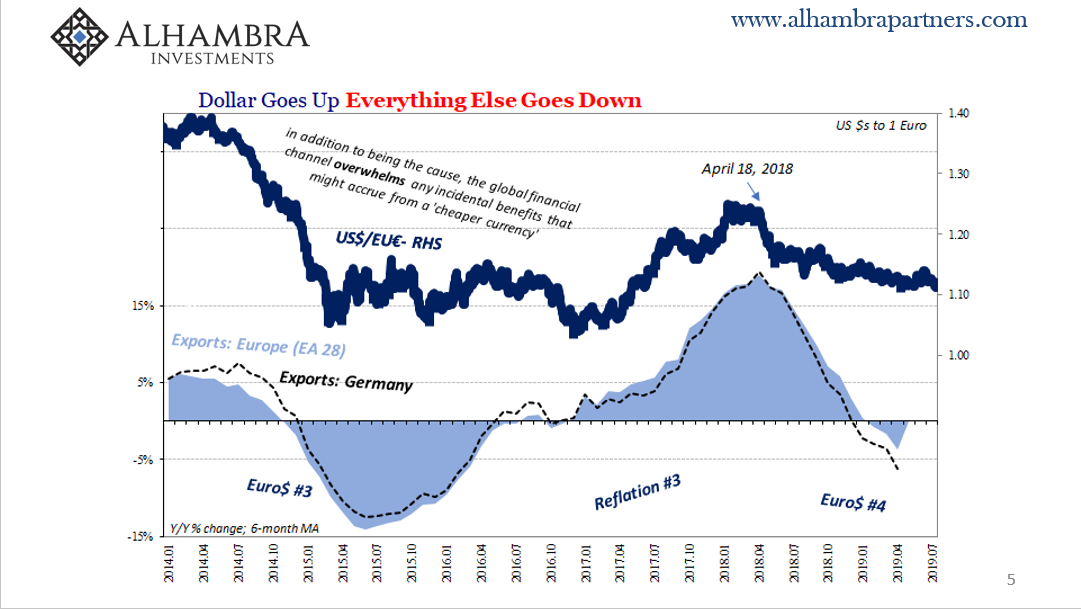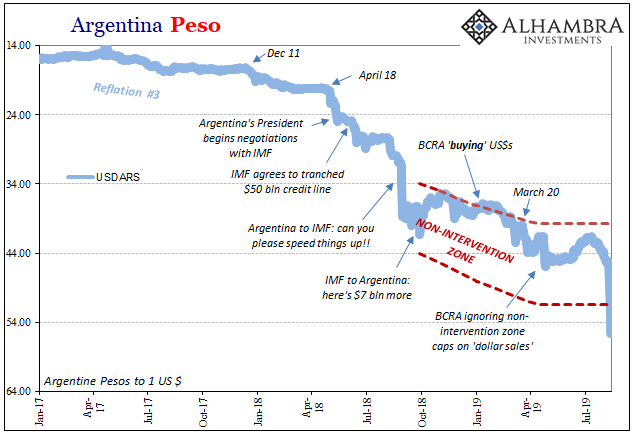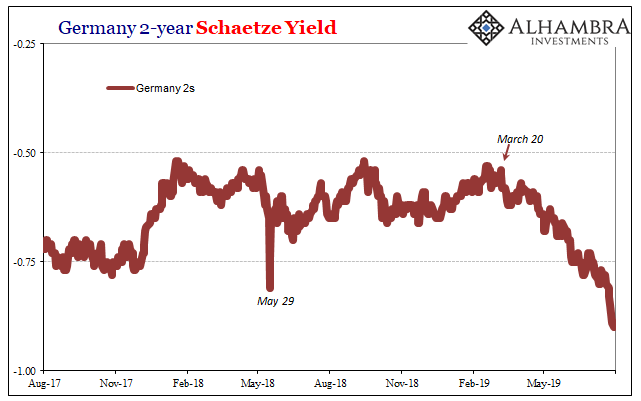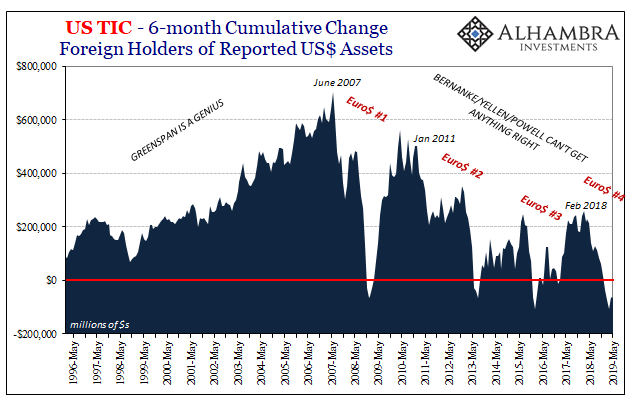Why don’t you fight the Fed? Sure, central banks and governments give off the impression that they are in control. The idea is repeated as if a fact. We are led to believe they let markets play around in their contained spheres but should anyone get out of hand authorities are there like referees to make sure everything remains inbounds. Whenever a price or an asset class approaches the boundary, woe be it to whomever might challenge the almighty holder of the printing press.
Yet, we see all the time how there’s so little underneath. Central bankers talk a good game, but that’s all they do is talk. Over the last twelve years in particular, whenever they have been less than politely invited to put up or shut up they’ve essentially put up more talk – yes, QE was all talk – and simply expected no one would notice.
Take the world of global exchange and currencies, for example. Even today we are expected to believe that powerful central bankers set the limits for how these things go and oversee everything in between. Should anything start to look different, even then we are told to believe that it can only be different by decree of that same central bank. Behind everything is this official purpose we aren’t privy to.
If China’s yuan has gone under 7.0, then by god that’s because the PBOC wants it that way! How else can we interpret the behavior?
That’s what motivated my last discussion with Erik Townsend on the MacroVoices channel. We are taught from the very beginning that central banks are central and in the case of China its central bank is doubly so. Not only does it have a printing press it also stands on top of the largest stockpile of foreign reserves ever conceived.

Therefore, at least outwardly, it seems clear cut that if CNY drops there must be some official reason for it.
Except, no, that’s not how it goes – as you can plainly see by nothing more than economic trends. Currency devaluation, if that’s what this is, just hasn’t worked. Rather than see exports or manufacturing pick up whenever the PBOC allegedly presses the deval button, we find the opposite. It’s a remarkable outcome, and a remarkably consistent outcome, that flies directly in the face of convention.
Armed with no other data than this, you might already surmise there must be something else going on here.


I’m often reminded of a quote published in the New York Times which recognized a tectonic shift in the power dynamics behind what actually motivates currencies and therefore global “flows.”
The world’s currency markets, it seems, are no longer governed by central bankers in Washington and Bonn, but by traders and investors in Tokyo, London and New York, as the chaos in the currency markets this past week has shown.
The startling implication of this quote isn’t just what is contained within its words, it is also how it was published all way back in September 1992. The article itself was written in light of the British pound which was supposedly being taken down by George Soros at the time.
Instead, the only reason Soros could manage such a feat was because there was now this enormous, growing eurodollar system behind everything which in the grand scheme of things had left a system “no longer governed by central bankers in Washington and Bonn” or Beijing.
The official world had been surpassed and superseded. And yet, this fact never made its way into the Economics courses and textbooks. The rest of the nineties would be devoted to the unexplained magic of Alan Greenspan and his quarter point fed funds moves.
As if to further prove the point, which sadly still needs to be proved to the mainstream where unexamined myths and legends pass for good editorial standards, there’s Argentina. Yes, the country is a mess but for almost two years it had been everyone’s darling.
Argentina’s finance minister Luis Caputo has been the world’s most visible bond salesman, so much so it’s a surefire guarantee that he has a bright future ahead on Wall Street however this all works out in South America. He even went so far as to successfully complete an underwriting for $2.75 billion of 100-year bonds in June last year [2017]. The coupon was just 7.1%.
What seemed like a sure thing under 2017’s globally synchronized growth turned back into the familiar nightmare as in 2018 globally synchronized growth melted under eurodollar scrutiny. With nowhere else to turn, Argentina went to the IMF.

What the IMF did at first was a traditional show of force. They promised tons of dollar loans to the struggling country, the biggest bailout in the organization’s long history. Within weeks, it had been overwhelmed anyway – the peso dropped even further. By the end of August 2018, despite that huge “rescue” the currency was in freefall.
In response, begged to do something, by September the IMF ponied up billions more and even got a little creative beside. To try and manage expectations, again all talk, IMF officials got Argentina’s central bank to commit to a non-intervention zone (what choice did the Argentinians really have?) As I wrote back in January:
At the upper limit, should the peso trend even sideways, with a depreciating band this would set up BCRA to actually purchase “dollars” and build up forex reserves all the while the peso continued to decline. A very neat little trick. This intervention would be limited to $50 million per day.
It was a scheme designed to (try to) use market expectations for a declining currency to the country’s advantage.
The peso hasn’t really improved nor yet has Argentina’s economy. It seems like the IMF has turned the tables on peso “speculators”, but it could just be those speculators are currently speculating (evilly) somewhere else at the moment. The Eurobond market, for one, isn’t yet buying Argentina’s turnaround.
Nor would it. On the one hand, the IMF with its largest bailout in history to go along with craftily implemented expectations policy to show the world no problem was too difficult or sizable to tackle with them around. On the other, same old eurodollar questions.
Who would win?
Long before the past few day’s resumed peso plunge, Argentina’s central bank had already broken the deal. In April, BCRA had scrapped the caps and would begin selling dollars up to $250 million a day even though the exchange rate was squarely in the non-intervention zone. There had been another “run” on the peso in late March, the other side of such “devaluation” being the dollar meaning dollar shortage (the aftermath of March 20 does seem to figure prominently all over the world).


The peso has been a dead currency walking since then. Its latest collapse certainly in reaction to changing political probabilities, but the weakness which left the currency so exposed to one is much more than that. In a world of a dollar shortage, the reaction to the slightest risk is swift, merciless and so far beyond the gabby capacities of global officials no matter how confident and creative.
The biggest bailout in the IMF’s history is already the equivalent of aged and stale gossip. What never changed for all the talking this last year and a half was the dollar shortage. The other side of “devaluation” is this forced dollar attrition.
Reserves and rescues, we are left instead to ponder and appreciate the lessons of September 1992. The eurodollar is far, far bigger and more uncontrollable than all the world’s central banks and official organizations spliced together end to end.
Not even China can corral its currency once the “dollar” gets started.
This the eurodollar’s world and it has been for decades. We are all just trying to live here as best we can – until the official sector stops talking and finally starts listening to and appreciating this long-established truth.


Stay In Touch